|
Cozzetti & Gemmill
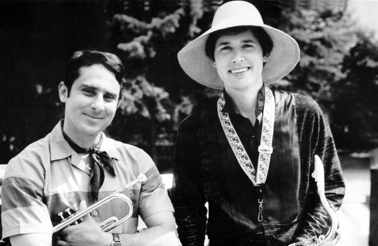 Bob Cozzetti and Tim Gemmill
(best known as Cozzetti & Gemmill)
met in Seattle, Washington in 1965 and became good friends In 1967. Tim was playing tenor saxophone & flute in the
Jimmy Hanna Big Band. Bob and
Jim Ogilvy (Jimmy Hanna) had grown up together on Capital Hill, in Seattle. He was helping Jim with some
management duties and occasionally playing trumpet in the band, as well. They soon formed a musical partnership marketing
themselves as a trumpet, saxophone and flute section for hire (primarily for rock and rhythm & blues bands). In 1968,
they drove to Los Angeles and spent a year playing with different groups; mostly rock. They
then traveled back east to Boston, Massachusetts. Their intent was to visit the
Berklee College of Music and check out the local jazz scene. After a few months,
they returned to Seattle to help form a six-piece avant-garde jazz orchestra: Cosmic Revolution Jazz Sextet.
Group members included Pete Leinonen (acoustic bass), Mike Jacobsen
(cello), Steve Swartz (drums) and Charles Jefferson (trumpet). Cozzetti performed on acoustic piano, while Gemmill
played tenor saxophone and flute. After the Cosmic Revolution Jazz Sextet broke up, Tim and Bob (along with drummer Steve Swartz)
joined a newly formed rock and R&B band: Ron Holden & Good News.
Ron Holden is remembered
for his 1959 ballad Love You So, which became an international top 10 hit, climbing to #7 in
Billboard. Other members were Toby Cyer (electric guitar) and Gary Snyder (electric
bass); known for his work with
Jimmy Hanna and the Dynamics. Cozzetti & Gemmill (and Swartz) spent a total of eight months with Ron Holden &
Good News.
Bob Cozzetti and Tim Gemmill
(best known as Cozzetti & Gemmill)
met in Seattle, Washington in 1965 and became good friends In 1967. Tim was playing tenor saxophone & flute in the
Jimmy Hanna Big Band. Bob and
Jim Ogilvy (Jimmy Hanna) had grown up together on Capital Hill, in Seattle. He was helping Jim with some
management duties and occasionally playing trumpet in the band, as well. They soon formed a musical partnership marketing
themselves as a trumpet, saxophone and flute section for hire (primarily for rock and rhythm & blues bands). In 1968,
they drove to Los Angeles and spent a year playing with different groups; mostly rock. They
then traveled back east to Boston, Massachusetts. Their intent was to visit the
Berklee College of Music and check out the local jazz scene. After a few months,
they returned to Seattle to help form a six-piece avant-garde jazz orchestra: Cosmic Revolution Jazz Sextet.
Group members included Pete Leinonen (acoustic bass), Mike Jacobsen
(cello), Steve Swartz (drums) and Charles Jefferson (trumpet). Cozzetti performed on acoustic piano, while Gemmill
played tenor saxophone and flute. After the Cosmic Revolution Jazz Sextet broke up, Tim and Bob (along with drummer Steve Swartz)
joined a newly formed rock and R&B band: Ron Holden & Good News.
Ron Holden is remembered
for his 1959 ballad Love You So, which became an international top 10 hit, climbing to #7 in
Billboard. Other members were Toby Cyer (electric guitar) and Gary Snyder (electric
bass); known for his work with
Jimmy Hanna and the Dynamics. Cozzetti & Gemmill (and Swartz) spent a total of eight months with Ron Holden &
Good News.
{Beginnings (1970-1972)}
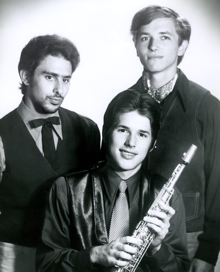 In 1970, Tim, Bob and Steve
left Ron Holden and formed a jazz-fusion group: Music Projection Trio, noteworthy for its lack of a bass player. MPT
got their first big break when they were invited by promoter and tenor saxophonist
Joe Brazil to open for
the
Herbie Hancock
Sextet, in October 1970, at Club Ebonee (Central District) Seattle. Also, in November,
Music Projection Trio performed at the Jazz Ragtime Festival with
Ramsey Lewis, the
late
John Lee Hooker,
the late
Jo Jordan
and the late
Eubie Blake.
Another setting for the trio was an appearance at a Seattle promotional event June 6, 1971, for the opening of the racing film
Le Mans (starring
Steve McQueen).
In August, 1971, Music Projection Trio performed for Rock Kaleidoscope at the
Seattle Center Mural
Amphitheatre; event sponsored by Seattle mayor
Wes Uhlman
(mayor from 1969-1978). Cozzetti received a letter from the mayors office thanking him: in the letter, dated September 9, 1971,
Mayor Uhlman wrote, "May I take this opportunity, on behalf of the people of Seattle, to thank you for the hours of help and
participation you gave to Festival 71 at the Seattle Center". In May 1972, MPT performed as an opening act for the
Charles
Lloyd Quartet at the Fresh Air Tavern; Seattle. Many well-known jazz and blues artists performed at this club, including
Albert Collins,
Johnny Otis and
Muddy Waters. In 1970, Tim, Bob and Steve
left Ron Holden and formed a jazz-fusion group: Music Projection Trio, noteworthy for its lack of a bass player. MPT
got their first big break when they were invited by promoter and tenor saxophonist
Joe Brazil to open for
the
Herbie Hancock
Sextet, in October 1970, at Club Ebonee (Central District) Seattle. Also, in November,
Music Projection Trio performed at the Jazz Ragtime Festival with
Ramsey Lewis, the
late
John Lee Hooker,
the late
Jo Jordan
and the late
Eubie Blake.
Another setting for the trio was an appearance at a Seattle promotional event June 6, 1971, for the opening of the racing film
Le Mans (starring
Steve McQueen).
In August, 1971, Music Projection Trio performed for Rock Kaleidoscope at the
Seattle Center Mural
Amphitheatre; event sponsored by Seattle mayor
Wes Uhlman
(mayor from 1969-1978). Cozzetti received a letter from the mayors office thanking him: in the letter, dated September 9, 1971,
Mayor Uhlman wrote, "May I take this opportunity, on behalf of the people of Seattle, to thank you for the hours of help and
participation you gave to Festival 71 at the Seattle Center". In May 1972, MPT performed as an opening act for the
Charles
Lloyd Quartet at the Fresh Air Tavern; Seattle. Many well-known jazz and blues artists performed at this club, including
Albert Collins,
Johnny Otis and
Muddy Waters.
{New York City Period (1972-1977)}
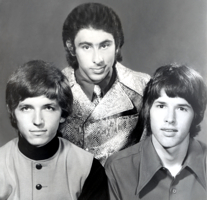 After moving to Hackensack, New Jersey
in September 1972, Cozzetti, Gemmill and Swartz continued to perform as Music Projection
Trio. One significant performance in Manhattan was appearing at the
Mercer Arts Center,
where they were regulars in the 'Blue Room' with
Albert Dailey. On
November 11-13, 1972, MPT performed at a Guest Appearance Showcase event at the
Village Gate
in Greenwich Village (NYC). They were asked back to perform at a later date. After moving to Hackensack, New Jersey
in September 1972, Cozzetti, Gemmill and Swartz continued to perform as Music Projection
Trio. One significant performance in Manhattan was appearing at the
Mercer Arts Center,
where they were regulars in the 'Blue Room' with
Albert Dailey. On
November 11-13, 1972, MPT performed at a Guest Appearance Showcase event at the
Village Gate
in Greenwich Village (NYC). They were asked back to perform at a later date.
In early 1973, Cozzetti & Gemmill changed the group name to
Rorschach
(after being told that their music resembled the ink-blot test). In March 1973, Rorschach opened for the legendary
Mongo Santamaría
Big Band at
Kennys Castaways in Manhattan's West Village. Santamaría was famous for salsa and Afro-Cuban music.
In a March 15, 1973 review, for the music industry trade magazine
Cash Box
(Billboards main competitor at the time), critic Robert Adels wrote "Rorschach is Bob Cozzetti on Fender Rhodes and trumpet,
Tim Gemmill on alto and tenor sax and Steve Schwartz on drums. Both Tim and Bob occasionally move over to maracas, but it's
Steve's inventive work which truly keeps the beat interesting."
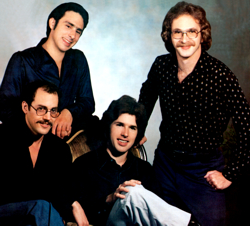 In the mid-1970s, Steve Swartz left the trio and Rorschach became a quartet with the addition of the late bassist
Midge Pike, whom had
performed with major jazz artists
Jackie McLean,
Albert Ayler and
Paul Winter. The lineup
during this period consisted of Cozzetti on trumpet or
Fender Rhodes electric
piano, Gemmill on tenor & soprano sax or Fender Rhodes electric piano, Pike (bass) and Wes Jensen or Bruce
Jackson (drums & percussion). Cozzetti & Gemmill, as co-leaders, rotated between horns and keyboards, sharing their
dual role up front. Cozzetti & Gemmill also continued to perform at club and concerts outside of New York City, traveling
back and forth between the east and west coasts. In Seattle, they often played with drummer
Fred Taylor
and electric bassists
Steve Bartlett or Bruce Phares. One such event was an appearance by Rorschach (Fred Taylor drums and Bruce
Phares bass) on May 22, 1976, with fusion guitarist
Larry Coryell, at the
Bellevue Jazz Festival; Bellevue Community College (Bellevue, Washington).
In the mid-1970s, Steve Swartz left the trio and Rorschach became a quartet with the addition of the late bassist
Midge Pike, whom had
performed with major jazz artists
Jackie McLean,
Albert Ayler and
Paul Winter. The lineup
during this period consisted of Cozzetti on trumpet or
Fender Rhodes electric
piano, Gemmill on tenor & soprano sax or Fender Rhodes electric piano, Pike (bass) and Wes Jensen or Bruce
Jackson (drums & percussion). Cozzetti & Gemmill, as co-leaders, rotated between horns and keyboards, sharing their
dual role up front. Cozzetti & Gemmill also continued to perform at club and concerts outside of New York City, traveling
back and forth between the east and west coasts. In Seattle, they often played with drummer
Fred Taylor
and electric bassists
Steve Bartlett or Bruce Phares. One such event was an appearance by Rorschach (Fred Taylor drums and Bruce
Phares bass) on May 22, 1976, with fusion guitarist
Larry Coryell, at the
Bellevue Jazz Festival; Bellevue Community College (Bellevue, Washington).
In May 1977, Rorschach returned to New York City, where they were invited to perform at an outdoor concert
series put on at
Lincoln Center. Midge Pike (bass) and Bruce Jackson (drums) performed at this Lincoln Center event, which reviewer Dick
Murphy briefly mentioned in a June 1, 1977 write up in his column And All That Jazz. Murphy wrote, "Another group, based in
New Jersey, just starting to make fusion statements in New York is Rorschach. They recently played to the afternoon crowd outside
Lincoln Center and they may develop into a band to reckon with."
Another well-known Manhattan venue that Rorschach performed at during this period was
The Bitter End,
located at 147 Bleecker Street (West Village). The Bitter End, which opened in 1961 (and was still open in 2024), is famous
for rock and folk, but has had some great jazz artists over the years (including
Mose Allison,
Chick Corea,
Stan Getz,
etc.). During Cozzetti & Gemmill's New York City period, Rorschach performed at the
United Nations and
were part of a summer concert series in
Brooklyn (including
performances at the Brooklyn Museums Theater in the Back).
Gemmill has many fond memories of working with Cozzetti during their years on the East Coast, and of the well-known musicians
they encountered - including the Michigan band Brownsville Station, whose leader, the late Cub Coda, was also known for his work
as a music journalist. At the invitation of Dick Weber of Big Tree Records, Cozzetti & Gemmill attended the session where Brownsville
Station recorded their album Yeah! and their 1973 smash "Smokin' in the Boys Room" (which became a major hit a second
time when it was covered by the heavy metal band Mötley Crüe in 1985).
Another famous rocker they met during their years on the East Coast was Philadelphia icon Todd Rundgren, famous for hits like "Hello,
It's Me" (which was covered by the Isley Brothers) and "I Saw the Light." Cozzetti & Gemmill met Rundgren through
Topper Schroeder of RCA Records.
Gemmill recalls, "We met Todd in Topper Schroeder's 5th Avenue apartment in Manhattan. We were there listening to Todd's new
album, which was not yet released. The album was A Wizard, which was released in 1973. Meeting Todd Rundgren was certainly interesting,
and being invited to a studio - with Brownsville Station there recording - was quite the experience for us."
New York City had a reputation for being rough in the 1970s - a side of the Big Apple famously depicted in movies like "Taxi Driver,"
"Death Wish" and "The French Connection." But Gemmill has good memories of those times and remembers how artistically rich
New York City was. "We were musicians," Gemmill comments. "Bob and I didn't worry. Nobody bothered us."
{Seattle: Late 1970s and 1980s}
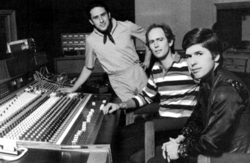
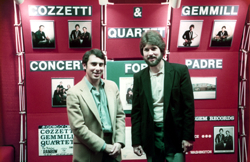 In late 1977, Cozzetti & Gemmill moved back to Seattle, where they continued to perform as Rorschach with Fred Taylor and
Steve Bartlett before changing the name of the group to the Cozzetti & Gemmill Quartet. They were hired to perform at
Parnells on January 13, 14 and 15, 1978. Parnells was the top jazz club in Seattle at that time. As the Cozzetti
& Gemmill Quartet, the group recorded its first album at Pacific West Recorders (Concerto For Padre) March 16, 1981 and asked jazz critic
Lee Underwood (who was
the West Coast editor of
Down Beat at that time) to
write liner notes. Concerto For Padre, released on Cozzetti & Gemmill's own label
Cozgem Records, has Cozzetti on
trumpet & acoustic piano, Gemmill on tenor & soprano sax, acoustic piano and Fender Rhodes electric piano, Steve Bartlett
(electric bass) and Fred Taylor (drums). In his liner notes, Underwood wrote, "As composers, conceptualizers and improvisers,
Cozzetti and Gemmill are well aware of the rich legacy handed them from the masters of the American jazz past. Their influences
include the immortal
John Coltrane, the
unique
McCoy Tyner, the funky
Horace Silver, and the
Prince of Darkness himself, the great
Miles Davis." Underwood
also commented on the LPs combination of acoustic and electric instruments and noted that the title Concerto For Padre was
dedicated to Cozzetti's father, Louis S. Cozzetti, who had passed away in 1974.
In late 1977, Cozzetti & Gemmill moved back to Seattle, where they continued to perform as Rorschach with Fred Taylor and
Steve Bartlett before changing the name of the group to the Cozzetti & Gemmill Quartet. They were hired to perform at
Parnells on January 13, 14 and 15, 1978. Parnells was the top jazz club in Seattle at that time. As the Cozzetti
& Gemmill Quartet, the group recorded its first album at Pacific West Recorders (Concerto For Padre) March 16, 1981 and asked jazz critic
Lee Underwood (who was
the West Coast editor of
Down Beat at that time) to
write liner notes. Concerto For Padre, released on Cozzetti & Gemmill's own label
Cozgem Records, has Cozzetti on
trumpet & acoustic piano, Gemmill on tenor & soprano sax, acoustic piano and Fender Rhodes electric piano, Steve Bartlett
(electric bass) and Fred Taylor (drums). In his liner notes, Underwood wrote, "As composers, conceptualizers and improvisers,
Cozzetti and Gemmill are well aware of the rich legacy handed them from the masters of the American jazz past. Their influences
include the immortal
John Coltrane, the
unique
McCoy Tyner, the funky
Horace Silver, and the
Prince of Darkness himself, the great
Miles Davis." Underwood
also commented on the LPs combination of acoustic and electric instruments and noted that the title Concerto For Padre was
dedicated to Cozzetti's father, Louis S. Cozzetti, who had passed away in 1974.
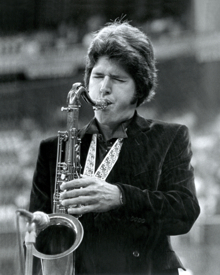
 In September of 1982, jazz critic Carl Brauer reviewed Concerto For Padre, in a column for
Cadence. Brauer
wrote that the performances vary from the modality of Raindrops to the solo piano performances of the title track.
In 1983, Cozzetti & Gemmill recorded their second vinyl album, Soft Flower in Spring, released on an independent
label (ITI Records).
The lineup consisted of Cozzetti, Gemmill, Bartlett (bass) and Bob Merrihew (drums). By this time, they were just calling
themselves Cozzetti & Gemmill. In a 1983 review for Downbeat, jazz critic A. James Liska wrote: "The democratic spirit
evident in Soft Flower in Spring, the second album by the twosomes quartet, reflects a rare cooperative effort in design,
direction and detail whose teamwork is as impressive as the music." A 1983 interview with Scott Grossman, of the Daily Bruin,
described some of the disappointments they had experienced with record companies during the 1970s. Gemmill told Grossman that
when they were still going by Rorschach, in 1972, they submitted a demo to an A&R representative at
Columbia Records;
the A&R man told them that he already had a similar group. That group was
Weather Report.
In September of 1982, jazz critic Carl Brauer reviewed Concerto For Padre, in a column for
Cadence. Brauer
wrote that the performances vary from the modality of Raindrops to the solo piano performances of the title track.
In 1983, Cozzetti & Gemmill recorded their second vinyl album, Soft Flower in Spring, released on an independent
label (ITI Records).
The lineup consisted of Cozzetti, Gemmill, Bartlett (bass) and Bob Merrihew (drums). By this time, they were just calling
themselves Cozzetti & Gemmill. In a 1983 review for Downbeat, jazz critic A. James Liska wrote: "The democratic spirit
evident in Soft Flower in Spring, the second album by the twosomes quartet, reflects a rare cooperative effort in design,
direction and detail whose teamwork is as impressive as the music." A 1983 interview with Scott Grossman, of the Daily Bruin,
described some of the disappointments they had experienced with record companies during the 1970s. Gemmill told Grossman that
when they were still going by Rorschach, in 1972, they submitted a demo to an A&R representative at
Columbia Records;
the A&R man told them that he already had a similar group. That group was
Weather Report.
According to Bob, Topper Schroeder (the A&R person for
Milestone Records)
expressed interest in signing Rorschach to Milestone, but that idea fell through when Schroder was hired by
RCA Records. Cozzetti
told Grossman that in 1978 & 1979, Cozzetti & Gemmill were signed to an independent label called Red Mark Records and hoped
that this label would be releasing an album by them. But, according to Cozzetti, "the company went into receivership and decided
to do away with their jazz label. So we didn't get our album out, we were hung up for two years in contracts, and we didn't even
get (the album) released."
{The 1990s and Beyond}
 After the 1980s, Cozzetti &
Gemmill continued to perform and write music but expanded into a variety of Web based projects. Rocka Records was started in
1994 in order to release a new CD: Timeless (compilation of vinyl recordings Concerto for Padre & Soft Flower
in Spring). Rocka Studios was involved in audio projects, A La Carte Web Design offered Web design & development
and Rocka.com (1999-2004) was a professional Internet Service Provider with 24/7 Web hosting services; setting up POP3/SMTP email
server accounts, full service website maintenance and free links on MallontheWeb.com and/or
MusicontheWeb.com. Customers included a
hip-hop record label in Manhattan, national artist (guitarist) in Nashville and a film production company in Los Angeles,
Cailfornia. Cozgem Studios now provides all graphic design and/or animations for MusicontheWeb.com (Music on the Web®),
as well as the graphics for albums produced by Cozgem Records. After the 1980s, Cozzetti &
Gemmill continued to perform and write music but expanded into a variety of Web based projects. Rocka Records was started in
1994 in order to release a new CD: Timeless (compilation of vinyl recordings Concerto for Padre & Soft Flower
in Spring). Rocka Studios was involved in audio projects, A La Carte Web Design offered Web design & development
and Rocka.com (1999-2004) was a professional Internet Service Provider with 24/7 Web hosting services; setting up POP3/SMTP email
server accounts, full service website maintenance and free links on MallontheWeb.com and/or
MusicontheWeb.com. Customers included a
hip-hop record label in Manhattan, national artist (guitarist) in Nashville and a film production company in Los Angeles,
Cailfornia. Cozgem Studios now provides all graphic design and/or animations for MusicontheWeb.com (Music on the Web®),
as well as the graphics for albums produced by Cozgem Records.
{Cozgem Records in the 2010s}
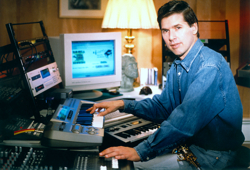 Cozgem Records has released three
CDs and a digital album (Internet only) in the last fourteen years. Timeless (2010) was digitally remastered (engineer;
Ashley Shepherd), with new graphics. Voyage of the Mummy (2011) has never-before-released material from their
1977 'live' performance at
Gerde's Folk City in Greenwich Village (NYC). The lineup is Gemmill (soprano saxophone), Cozzetti (Fender Rhodes
electric piano), the late Midge Pike (bass) and Wes Jensen (drums). Except for a performance of John Coltrane's Cousin Mary,
Cozzetti & Gemmill perform original songs on Voyage of the Mummy. In December 2013, Cozzetti & Gemmill co-produced
a new CD by Tim Gemmill: Road Songs, which was released on the Cozgem label under his own name. Cozgem Records has released three
CDs and a digital album (Internet only) in the last fourteen years. Timeless (2010) was digitally remastered (engineer;
Ashley Shepherd), with new graphics. Voyage of the Mummy (2011) has never-before-released material from their
1977 'live' performance at
Gerde's Folk City in Greenwich Village (NYC). The lineup is Gemmill (soprano saxophone), Cozzetti (Fender Rhodes
electric piano), the late Midge Pike (bass) and Wes Jensen (drums). Except for a performance of John Coltrane's Cousin Mary,
Cozzetti & Gemmill perform original songs on Voyage of the Mummy. In December 2013, Cozzetti & Gemmill co-produced
a new CD by Tim Gemmill: Road Songs, which was released on the Cozgem label under his own name.
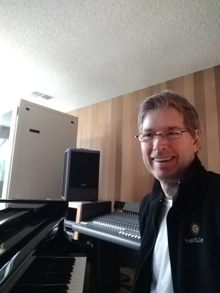 Gemmill's sequel to Road Songs, titled Road Songs 2, was released by Cozgem Records in 2017. In his liner
notes for Road Songs 2, journalist Alex Henderson noted that Cozzetti & Gemmill produced the album together but described
Gemmill as the one in the drivers seat. According to Henderson, In addition to playing all of the instruments himself and
providing the sounds of everything from drums and bass to keyboards, Gemmill composed most of the material on Road Songs 2.
Henderson's liner notes quoted Gemmill as saying, "Bob was a consultant on Road Songs 2. When I was recording this album,
Bob would come over and listen and comment on what I was doing. I would show Bob what I was working on and get his input."
Gemmill's sequel to Road Songs, titled Road Songs 2, was released by Cozgem Records in 2017. In his liner
notes for Road Songs 2, journalist Alex Henderson noted that Cozzetti & Gemmill produced the album together but described
Gemmill as the one in the drivers seat. According to Henderson, In addition to playing all of the instruments himself and
providing the sounds of everything from drums and bass to keyboards, Gemmill composed most of the material on Road Songs 2.
Henderson's liner notes quoted Gemmill as saying, "Bob was a consultant on Road Songs 2. When I was recording this album,
Bob would come over and listen and comment on what I was doing. I would show Bob what I was working on and get his input."
Gemmill, Henderson said, composed six of the seven selections on Road Songs 2, including Super Cool, Proteus 2,
Moog Blues, A Little Something, Groove On and the Asian-flavored Domo Arigato. The only track on Road Songs 2
that Gemmill didn't compose, according to Henderson, was an arrangement of John Williams and Leslie Bricusses Can You Read My
Mind?, originally heard in the late 1970s movie Superman (which starred
Margot Kidder
and the late
Christopher Reeve). Henderson wrote, "In its 1979 incarnation, Can You Read My Mind? was an adult contemporary
ballad performed by singer
Maureen McGovern. Gemmill, however, performs Williams melody without Bricusses lyrics, putting a funkier spin on
the song and taking it more in the direction of fusion. And while Gemmill employs sampled wordless background vocals on Can
You Read My Mind?, it is essentially an instrumental performance."
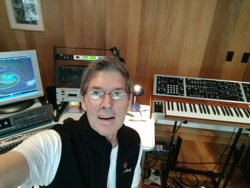 Henderson's liner notes quoted Gemmill as describing his work on Road Songs 2 as that of a digital orchestra. According
to Henderson, "Road Songs 2 finds Gemmill using synthesizers that range from the UltraProteus to the Memorymoog."
Henderson quoted Gemmill as saying, "I really do have a digital orchestra on this album. I'm writing the parts for all the
instruments, and I play everything. That's the fun part about it: being able to sit there at the computer and feel like I'm
composing for a whole band, a whole orchestra. To me, that's enjoyable."
Henderson's liner notes quoted Gemmill as describing his work on Road Songs 2 as that of a digital orchestra. According
to Henderson, "Road Songs 2 finds Gemmill using synthesizers that range from the UltraProteus to the Memorymoog."
Henderson quoted Gemmill as saying, "I really do have a digital orchestra on this album. I'm writing the parts for all the
instruments, and I play everything. That's the fun part about it: being able to sit there at the computer and feel like I'm
composing for a whole band, a whole orchestra. To me, that's enjoyable."
Henderson described Road Songs 2 as an album that combines jazz, funk, soul and rock elements. Henderson said, It is no
coincidence that some of the song titles on Road Songs 2, especially Super Cool and Groove On, would not have been
out of place on a
Kool & the Gang, Parliament/Funkadelic or
Bar-Kays album
from the 1970s. Henderson quoted Gemmill as saying, "Bob and I grew up on John Coltrane, but Road Songs 2 has more of the
R&B and funk influence. When I'm working, I sometimes find myself asking, ‘What would James Brown do?’ And sometimes,
‘What would Miles Davis do?’ Miles would create some really interesting sounds."
{The Cozzetti & Gemmill Studio: 1999-2022}
In addition to their many accomplishments as musicians, composers, producers and arrangers, Cozzetti & Gemmill have their
own studio in Washington State - and it is in that studio that Gemmill plans to record a Road Songs 3 album in the future. The
studio has been in operation for 23 years, and along the way, it has expanded considerably.
"Our studio was initially a server room for Rocka.com, from 1999-2004, with an audio and video editing station for
Music on the Web® that I have maintained since 1997," Gemmill explains. "We had a grand piano, 7' Schimmel, and our
Memorymoog, built in 1980. I decided to start adding hardware in early 2000 for recording purposes. Our first recording device
was a Soundscape Hard Disk Recorder, but we found the recording quality to be better with an Alesis ADAT 8-track recorder - which
was perfect for a two-man digital studio."
Describing the equipment in their studio, Gemmill adds, "There are five main instruments - Prophecy solo synth, primarily
used for bass; Roland drum and percussion synthesizer, a Kawaii central keyboard; an UltraProteus synth for soloing; and, of course,
our Memorymoog. Samplers are also employed for voice and/or effects. The studio has cedar walls and flooring and double pane
windows for sound proofing."
In addition to using the studio to record a Road Songs 3 project in the future, Gemmill plans to use the studio to record a new
Cozzetti & Gemmill album with the goal of "bringing some of our compositions from the 1970s and 1980s into the digital
world."
Gemmill notes, "I also want to combine the acoustic with the electronic by including some solo piano works by Bob. He
did get a piano lesson from
Herbie Hancock in 1970. All of the engineering tasks are handled by me. We only require outside studio help for mixing
and mastering to create the master discs. I create the audio files myself for online distribution. Our music is currently available
on Apple, Spotify and YouTube, etc."
{Encounters With Iconic Musicians: 1970s-2020s}
Over the years, Cozzetti & Gemmill had the pleasure of interacting with some of music's most iconic figures - including Herbie
Hancock and Mary Wilson, best known for performing alongside Diana Ross as a member of the Supremes during the 1960s.
When Hancock visited Seattle in 1970, Cozzetti was honored to get a piano lesson from him.
"I mean, who gets a piano lesson from Herbie Hancock?" Gemmill recalls. "Herbie was in town, performing at the Jazz
Spectacular in October 1970 with his new sextet after leaving Miles Davis. I was playing in a jazz orchestra, sitting next to Joe Brazil,
who had started a promotional company. Joe had set up a gig at the Club Ebonee in Seattle and wanted Herbie's group to perform. Herbie
needed our electric piano to do the gig. We were also asked to open for his band."
Wilson, in fact, lived across the street from Cozzetti & Gemmill in Henderson, Nevada (a Las Vegas suburb), prior to her death in
February 2021.
Gemmill fondly remembers, "Bob had spoken with Mary several times. She was very nice to him. He had given her our albums and she
looked us up on Wikipedia, etc."
It is with great sadness that we announce the passing of Robert J. Cozzetti on July 9, 2023.
Alex Henderson
April, 2024
alexvhenderson.com
{Discography}
 2017: Tim Gemmill -
Road Songs 2 (Cozgem Records)
2017: Tim Gemmill -
Road Songs 2 (Cozgem Records)
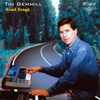 2013: Tim Gemmill -
Road Songs (Cozgem Records)
2013: Tim Gemmill -
Road Songs (Cozgem Records)
 2011: Cozzetti & Gemmill (Rorschach) -
Voyage of the Mummy (Cozgem Records)
2011: Cozzetti & Gemmill (Rorschach) -
Voyage of the Mummy (Cozgem Records)
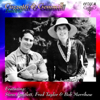 2010: Cozzetti & Gemmill -
Timeless (Cozgem Records)
2010: Cozzetti & Gemmill -
Timeless (Cozgem Records)
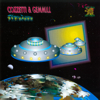 1994: Cozzetti & Gemmill -
Timeless (Rocka Records)
1994: Cozzetti & Gemmill -
Timeless (Rocka Records)
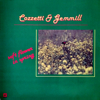 1984: Cozzetti & Gemmill -
Soft Flower in Spring (ITI Records)
1984: Cozzetti & Gemmill -
Soft Flower in Spring (ITI Records)
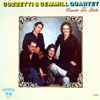 1981: C&G Quartet -
Concerto For Padré (Cozgem Records)
1981: C&G Quartet -
Concerto For Padré (Cozgem Records)
|
 Bob Cozzetti and Tim Gemmill
(best known as
Bob Cozzetti and Tim Gemmill
(best known as  In 1970, Tim, Bob and Steve
left Ron Holden and formed a jazz-fusion group: Music Projection Trio, noteworthy for its lack of a bass player. MPT
got their first big break when they were invited by promoter and tenor saxophonist
In 1970, Tim, Bob and Steve
left Ron Holden and formed a jazz-fusion group: Music Projection Trio, noteworthy for its lack of a bass player. MPT
got their first big break when they were invited by promoter and tenor saxophonist
 After moving to Hackensack, New Jersey
in September 1972, Cozzetti, Gemmill and Swartz continued to perform as Music Projection
Trio. One significant performance in Manhattan was appearing at the
After moving to Hackensack, New Jersey
in September 1972, Cozzetti, Gemmill and Swartz continued to perform as Music Projection
Trio. One significant performance in Manhattan was appearing at the
 In the mid-1970s, Steve Swartz left the trio and Rorschach became a quartet with the addition of the late bassist
In the mid-1970s, Steve Swartz left the trio and Rorschach became a quartet with the addition of the late bassist

 In late 1977, Cozzetti & Gemmill moved back to Seattle, where they continued to perform as Rorschach with Fred Taylor and
Steve Bartlett before changing the name of the group to the Cozzetti & Gemmill Quartet. They were hired to perform at
In late 1977, Cozzetti & Gemmill moved back to Seattle, where they continued to perform as Rorschach with Fred Taylor and
Steve Bartlett before changing the name of the group to the Cozzetti & Gemmill Quartet. They were hired to perform at

 In September of 1982, jazz critic Carl Brauer reviewed Concerto For Padre, in a column for
In September of 1982, jazz critic Carl Brauer reviewed Concerto For Padre, in a column for
 After the 1980s, Cozzetti &
Gemmill continued to perform and write music but expanded into a variety of Web based projects. Rocka Records was started in
1994 in order to release a new CD: Timeless (compilation of vinyl recordings Concerto for Padre & Soft Flower
in Spring). Rocka Studios was involved in audio projects, A La Carte Web Design offered Web design & development
and Rocka.com (1999-2004) was a professional Internet Service Provider with 24/7 Web hosting services; setting up POP3/SMTP email
server accounts, full service website maintenance and free links on MallontheWeb.com and/or
After the 1980s, Cozzetti &
Gemmill continued to perform and write music but expanded into a variety of Web based projects. Rocka Records was started in
1994 in order to release a new CD: Timeless (compilation of vinyl recordings Concerto for Padre & Soft Flower
in Spring). Rocka Studios was involved in audio projects, A La Carte Web Design offered Web design & development
and Rocka.com (1999-2004) was a professional Internet Service Provider with 24/7 Web hosting services; setting up POP3/SMTP email
server accounts, full service website maintenance and free links on MallontheWeb.com and/or
 Cozgem Records has released three
CDs and a digital album (Internet only) in the last fourteen years. Timeless (2010) was digitally remastered (engineer;
Ashley Shepherd), with new graphics. Voyage of the Mummy (2011) has never-before-released material from their
1977 'live' performance at
Cozgem Records has released three
CDs and a digital album (Internet only) in the last fourteen years. Timeless (2010) was digitally remastered (engineer;
Ashley Shepherd), with new graphics. Voyage of the Mummy (2011) has never-before-released material from their
1977 'live' performance at
 Gemmill's sequel to Road Songs, titled Road Songs 2, was released by Cozgem Records in 2017. In his liner
notes for Road Songs 2, journalist Alex Henderson noted that Cozzetti & Gemmill produced the album together but described
Gemmill as the one in the drivers seat. According to Henderson, In addition to playing all of the instruments himself and
providing the sounds of everything from drums and bass to keyboards, Gemmill composed most of the material on Road Songs 2.
Henderson's liner notes quoted Gemmill as saying, "Bob was a consultant on Road Songs 2. When I was recording this album,
Bob would come over and listen and comment on what I was doing. I would show Bob what I was working on and get his input."
Gemmill's sequel to Road Songs, titled Road Songs 2, was released by Cozgem Records in 2017. In his liner
notes for Road Songs 2, journalist Alex Henderson noted that Cozzetti & Gemmill produced the album together but described
Gemmill as the one in the drivers seat. According to Henderson, In addition to playing all of the instruments himself and
providing the sounds of everything from drums and bass to keyboards, Gemmill composed most of the material on Road Songs 2.
Henderson's liner notes quoted Gemmill as saying, "Bob was a consultant on Road Songs 2. When I was recording this album,
Bob would come over and listen and comment on what I was doing. I would show Bob what I was working on and get his input."
 Henderson's liner notes quoted Gemmill as describing his work on Road Songs 2 as that of a digital orchestra. According
to Henderson, "Road Songs 2 finds Gemmill using synthesizers that range from the UltraProteus to the Memorymoog."
Henderson quoted Gemmill as saying, "I really do have a digital orchestra on this album. I'm writing the parts for all the
instruments, and I play everything. That's the fun part about it: being able to sit there at the computer and feel like I'm
composing for a whole band, a whole orchestra. To me, that's enjoyable."
Henderson's liner notes quoted Gemmill as describing his work on Road Songs 2 as that of a digital orchestra. According
to Henderson, "Road Songs 2 finds Gemmill using synthesizers that range from the UltraProteus to the Memorymoog."
Henderson quoted Gemmill as saying, "I really do have a digital orchestra on this album. I'm writing the parts for all the
instruments, and I play everything. That's the fun part about it: being able to sit there at the computer and feel like I'm
composing for a whole band, a whole orchestra. To me, that's enjoyable."
 2017: Tim Gemmill -
2017: Tim Gemmill -
 2013: Tim Gemmill -
2013: Tim Gemmill -
 2011: Cozzetti & Gemmill (Rorschach) -
2011: Cozzetti & Gemmill (Rorschach) -
 2010: Cozzetti & Gemmill -
2010: Cozzetti & Gemmill -
 1994: Cozzetti & Gemmill -
1994: Cozzetti & Gemmill -
 1984: Cozzetti & Gemmill -
1984: Cozzetti & Gemmill -
 1981: C&G Quartet -
1981: C&G Quartet -